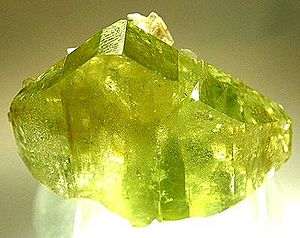Brazilianite facts for kids
Brazilianite is a special kind of mineral. It's usually yellow-green and is found in rocks called pegmatites. These rocks are rich in a substance called phosphate. Brazilianite got its name because it was first discovered in Brazil.
Contents
What is Brazilianite?
Brazilianite is a mineral that belongs to the group of phosphate minerals. This means it contains phosphate as a main part of its chemical makeup. Its full chemical name is sodium aluminium phosphate hydroxide.
What Does Brazilianite Look Like?
Brazilianite crystals are often yellow, green, or sometimes even clear. They usually grow in a shape called "prismatic," which means they look like long, thin columns. Sometimes, you can find them grouped together in beautiful clusters called "druses."
When you look at Brazilianite, it often has a shiny, glass-like surface. This is called a "vitreous" luster. It can be clear enough to see through (transparent) or a bit cloudy (translucent).
On the Mohs scale of hardness, Brazilianite is a 5.5. This means it's harder than glass but not as hard as quartz.
Where is Brazilianite Found?
Brazilianite is often found in special rock formations called pegmatites. These are igneous rocks that form when magma cools slowly, allowing large crystals to grow.
One of the most famous places to find Brazilianite is near Conselheiro Pena in Minas Gerais, Brazil. Here, you can find very perfect crystals. Some of these crystals can be quite large, measuring up to 12 centimeters (about 4.7 inches) long! They can be dark greenish-yellow to olive-green.
Another place in Minas Gerais, near Mantena, also has Brazilianite crystals. While they are similar in size, they might not be as perfectly shaped as those from Conselheiro Pena.
Brazilianite has also been found in the United States. Many crystals in mineral collections come from the Palermo and Charles Davis mines in Grafton County, New Hampshire.
Brazilianite as a Gemstone
Because of its beautiful colors and clear crystals, Brazilianite is sometimes used as a gemstone. It can be cut and polished to make lovely jewelry.
Images for kids
-
Brazilianite crystals on muscovite, Galilea mine, Minas Gerais, Brazil
See also
 In Spanish: Brasilianita para niños
In Spanish: Brasilianita para niños



